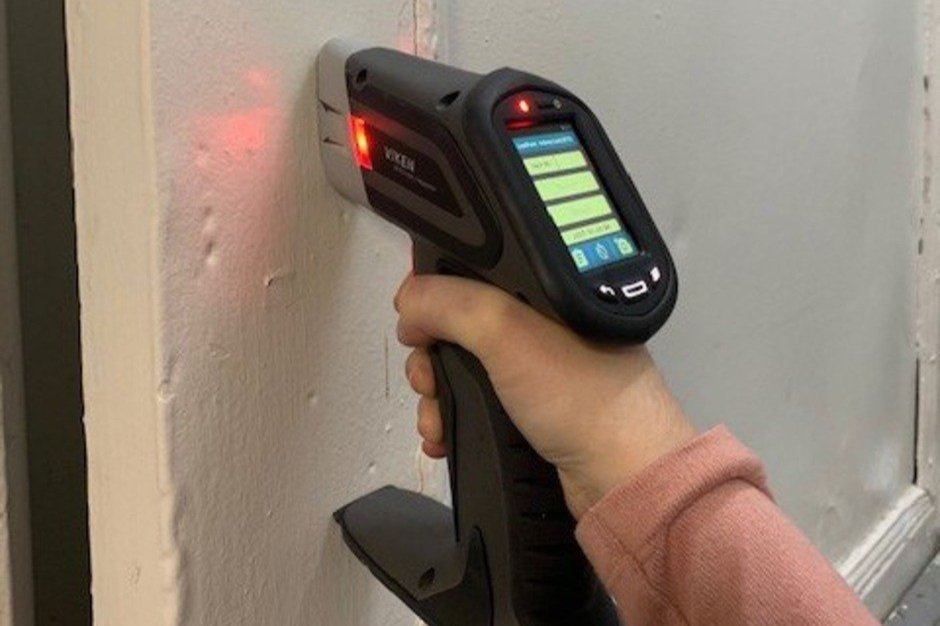Protect your family and property with lead-based paint inspection services from MSE Environmental. Learn about the dangers of lead in paint and how we can help. Lead-based paint is a type of paint that contains lead as an additive. Lead was a popular paint ingredient until the late 1970s when it became clear that it was dangerous. Since then, authorities have banned lead in paint, but many older homes and buildings still have it.
The value of lead-based paint inspections
Lead-based paint is harmful to your health, especially for kids under the age of six and pregnant women. Lead can harm the brain, nervous system, behavior, and learning. Because of this, lead-based paint checks are necessary for finding where it might be in a home or building.
A lead-based paint inspection is also a must if you are buying or renting a home or building made before 1978. This inspection can detect lead paint on the building and its condition. A lead-based paint inspection is often needed by law, mainly before you sell or rent a home.
You can keep yourself and others safe if you know about lead-based paint and how important inspections are.
What is Lead-Based Paint?
Lead-based paint is a type of paint that was commonly used in homes and buildings before the 1970s. The paint contained lead, which can harm infants and pregnant women. The United States banned lead-based paint in 1978, but many older homes and buildings still have it.
How to Test for Lead-Based Paint
If you suspect that your home or property was built before 1978, it is important to have it tested. Know the pros and cons of lead-based paint testing methods.
There are two primary methods for testing lead-based paint:
X-ray fluorescence (XRF) testing detects the amount of lead in paint using a portable tool. This method is non-destructive and works right away.
Paint chip analysis can involve taking paint samples for lab testing. This method is more accurate but destructive; it takes time to get results.
Both XRF and paint chip analysis have their pros and cons. XRF testing is faster and less invasive. However, it may not be accurate when the paint is covered by several layers of newer paint. Paint chip analysis is more exact but could be messy and lengthy.
Lead-based paint inspection costs depend on the method used and the area size to be tested. Most of the time, XRF testing costs less than analyzing paint chips.
A licensed expert should test for lead-based paint for accurate results. MSE Environmental is a firm that, among other things, tests lead-based paint. They are licensed and have the skills to accurately and safely test lead-based paint.
It is important to test for lead-based paint to keep your family safe. The cost of testing may seem daunting, but it is an insignificant price to pay for peace of mind.
The Risks of Lead-Based Paint
The risks to health from being exposed to lead
Lead-based paint is harmful because it can break down over time and send lead dust and particles into the air. When people breathe in or swallow these particles, lead can poison them. Lead poisoning can cause many health problems, like slow growth, trouble learning, bad behavior, and even death.
Risks for children and pregnant women
Children and women who are pregnant are especially at risk of the harmful effects of lead. Lead-based paint may slow growth for kids, lower their IQ, and cause problems with learning and behavior. Lead exposure while pregnant can cause premature birth, low birth weight, and problems with cognition in babies.
The Lasting Impacts of Lead
Even after the lead exposure has stopped, the effects can last long. For instance, children subjected to lead may have kidney damage, high blood pressure, and other health problems as adults.
It is important to take lead-based paint risks seriously and take steps for yourself and your family. This means finding and fixing any problems with lead-based paint in your house or your property.
MSE Environmental can find and fix lead-based paint issues to guard your family's health. Their skilled team can do checks of lead-based paint, risk assessments, and safe lead removal.
Dealing with Lead-Based Paint
There are a number of solutions accessible if you find lead-based paint in your home. There are pros and cons to every potential course of action, so pick your path with care.
1. Choices for dealing with lead-based paint:
Paint over it: One option is simply to paint over lead-based paint. The new paint will cover the lead-based paint, making this a temporary fix.
Encapsulation: Encapsulation uses a special layer to seal the paint with lead. This is a better long-term option that can work if done right.
Removal: The best thing to do is to take off all of the lead-based paint. It is laborious and costly, but the only way to ensure your home is lead-free.
2. Pros and cons of each option:
Painting over: This is a cheap and easy fix but only temporary. The lead-based paint will eventually show through, and you must deal with it again.
Encapsulation: This is a more permanent option, but it can be costly and needs an expert to do it right.
Removal: This is the best option but is also the most expensive and takes the most time. It may also need an expert to ensure it's done safely and properly.
3. The value of choosing an expert:
No matter what you choose, hiring an expert who has dealt with lead-based paint is important. They can ensure the work is done safely and correctly and help you choose the best option.
4. What MSE Environmental can do for you:
MSE Environmental is a business that deals in lead-based paint checks, risk assessments, and removal services. They know how to help homes and building owners safely and effectively deal with lead-based paint. If your home or business has paint made with lead, call MSE Environmental.
Lead-Based Paint Disclosure
When buying or renting a home built before 1978, it's important to know that it might have lead-based paint. Federal law says that sellers and owners of these houses must tell buyers or renters that the paint contains lead.
Who is required to provide a disclosure?
The lead-based paint disclosure is a document that shows risks to property and the dangers of lead. Before signing any contracts or deals to buy or rent the property, the buyer or tenant must be informed.
The seller or landlord must disclose lead-based paint. Buyers and renters of pre-1978 buildings must get a pamphlet about lead-based paint risks from the EPA.
What happens if you don't give a disclosure?
If the seller or owner doesn't give the information, they could get in trouble with the law. In addition to fines, they could be held responsible for any injuries or losses caused by the lead.
Buyers and landlords should ask questions if they are concerned about lead-based paint. By working together, buyers, renters, sellers, and owners can make sure the safety of everyone involved.
Who pays for the lead-based paint inspection?
One common question about lead-based paint tests is who pays for them. The buyer usually pays for lead-based paint tests, but the answer can change depending on the case.
In some cases, sellers may opt to have their property inspected for lead-based paint before listing it for sale. This can help them figure out any problems ahead of time and make their house worth more.
Most of the time, the buyer pays for lead-based paint inspections.
Pros and cons of each party paying
There are pros and cons to each party paying for lead-based paint inspections. If the seller pays for the inspection, they have more control over the process and can choose the inspector. However, if the buyer pays for the inspection, they can choose the tester they trust.
It's important to know that lead-based paint checks may be a loan condition for some lenders or government programs. Depending on the loan or program, the buyer or seller may pay for the check.
The value of dealing with real estate costs for inspection
When buying or selling a home, buyers, and sellers often discuss who will pay for different costs. This includes the lead-based paint inspection cost. Remember that buyers and sellers can talk about all the costs of selling a home.
Buyers are typically the ones paying for the cost of lead-based paint checks. Buyers and sellers can talk about inspection prices and find a solution that does the trick for both parties.
Should I waive lead-based paint inspection?
A lead-based paint check is important when buying a home or other property. Lead-based paint can be very bad for your health, especially for kids and women who are pregnant. Some buyers might skip the check to save time or money. But is it worth it?
Reasons for Skipping Lead-Based Paint Inspection
Some buyers might think about not having a lead-based paint test done because:
The property was built after 1978: Lead-based paint was banned for residential use in 1978. If the property was built after this year, it is highly unlikely to have lead-based paint.
The seller has already provided a disclosure: Federal law says sellers must tell buyers what they know about lead-based paint in the home. If the seller has already disclosed, the buyer may not need to do a check.
Limited budget: Inspections for lead-based paint can be costly, and some sellers may need more money to cover the costs.
Potential Effects of Waiving a Lead-Based Paint Inspection
Choosing not to have a lead-based paint check can have bad results, such as:
Health risks: Paint made with lead can cause serious health issues, especially for kids and women who are pregnant. If the buyer skips the check, they are putting themselves and their family at risk.
Financial consequences: If lead-based paint is found in the house later, getting rid of it can cost a lot. Sometimes, the whole property might need to be gutted, which can be expensive and cause much trouble.
Legal issues: If a buyer waives a lead-based paint inspection and finds lead paint, the seller may not be liable.
Considerations for skipping inspections
When choosing whether to skip a lead-based paint inspection, buyers must weigh the following:
Age of the property: If the property was built before 1978, it is highly likely to have lead-based paint. In this case, it is essential to have an inspection to ensure the safety of the occupants.
Presence of children or pregnant women: A lead-based paint inspection is a must if children or pregnant women stay on the property. Being around lead has big health risks, so taking chances is not a good idea.
Negotiating costs: Buyers can negotiate with the seller to cover the inspection cost. Dealing with the seller can save money if cost is the only reason to waive the check.
All things considered, you shouldn't skip a lead-based paint inspection. Lead poisoning comes with many risks, and getting rid of paint made with lead can be expensive. Before choosing whether or not to skip the inspection, buyers should consider the above things. Furthermore, remember that the safety of the people living there should be your top concern when buying a home.
To Recapitulate:
Inspections for lead-based paint make sure a home or building is safe. Older homes and buildings with lead-based paint pose health risks for children and pregnant women. As such, knowing the risks well and taking the steps needed to protect yourself and others is important.
Lead-based paint can be tested using various methods, each with pros and cons. Testing may be costly, but it's worth it for worker safety and well-being.
There are several ways to deal with paint made with lead, such as encapsulation, removal, and control. To be safe and effective, consider each option's pros and cons and hire a pro.
Lead-based paint rules make sure that buyers and renters don't buy or rent a home with lead paint without knowing it. All parties in a property deal must follow these laws to avoid legal complications.














Learn how to safely remove asbestos with MSE Environmental’s professional asbestos testing and consulting services for insurance and restoration contractors.